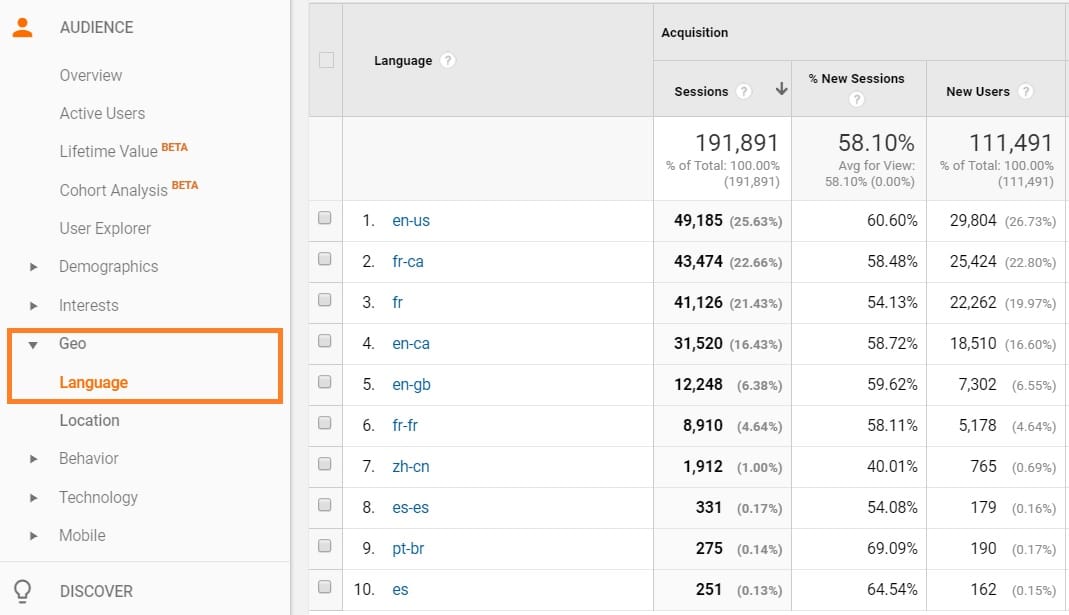Digital Media Campaign Manager
Do you speak the same language as your customers?
Digital Media Campaign Manager
Bilingualism is gaining ground in Canada: according to 2016 census data, 18% of Canadians are fluent in both official languages (English and French). But there are still more than 8 out of 10 inhabitants who speak only one of these 2 languages. Therefore, it is important to ensure that you are speaking to your customers in the correct language, so that they can understand you.
Especially since, on a global scale, multilingualism is not a Canadian exception. Other countries see their population speak several dialects: Belgium (French and Dutch), Switzerland (French, German and Italian), Spain (Spanish, Catalan and Basque), South Africa (English and Afrikaans) , China (Mandarin and Cantonese), etc.
At Adviso, the fact of evolving in this multilingual environment, but also of working on international projects ( Cirque du Soleil , Lasik MD , etc.), taught us to develop some reflexes on the management of languages on the web. In this article, we will detail how we apprehend them on search engines, in particular within the framework of paid referencing campaigns (SEM).

HOW TO TARGET THE RIGHT LANGUAGE?
The interface language is base targeting. In Adwords or Bing Ads, it is the language in which the Internet user has configured his Google or Microsoft search engine that you are targeting (and not his language of use, which could have been defined in a cookie).
This situation is not without raising some questions of relevance: indeed, the linguistic parameter of the interface is not always the reflection of the language that the user speaks. For example, at Adviso, we have, for the most part, our search engine in English, although we are French-speaking. And our experience shows that this situation (or the reverse) is not unique to Adviso, and concerns many people in Quebec, and especially in Montreal.
So, if the number of interfaces in a given language does not reflect the number of actual speakers of that language, what should be done?
TARGET THE LANGUAGE OF THE KEYWORD AND NOT THAT OF THE BROWSER
This is the solution we use to ensure that we are targeting the user in the correct language. Rather than aiming for that of his search engine, we favor his language of use, that is to say the one he uses when he browses the web. As queries become more and more conversational, Internet users have the reflex to carry out their research in their mother tongue.
Another advantage: targeting the language of the keyword rather than that of the browser makes it possible to properly target voice searches , part of which is done on interfaces for which it is not possible to target the language (domestic assistants, such as Google Home or Amazon Echo) .
When you create SEM campaigns targeting queries in a specific language (example: all keywords in French), remember not to specify language parameters . Thus, you will make sure to reach everyone, and not to hide, for example, French speakers who use Google in English.

THE SPECIAL CASE OF YOUR BRAND NAME
Targeting keyword language has a limit, however: terms related to your brand. Indeed, like all proper nouns, these queries cannot be assigned to a particular language, or translated.
For example, "Apple" remains "Apple" worldwide, and does not become "Pomme" in Quebec or "Manzana" in Mexico. In this specific case, this term does not allow you to know the language in which the search was carried out.
To determine the right language to display in the ads of your “Brand” campaigns, you will have to make a choice. This may be guided by the law (Law 101 in Quebec will make you choose French), or statistics (in Brussels, French speakers outnumber Dutch speakers).
But it is also possible to address your brand campaigns in several languages. In this case, you will create different campaigns, each of them targeting a different language (one targeting French-speaking browsers and displaying ads in French, another in English targeting English-speaking interfaces, etc.). Again, the combinations can be endless and it is important that you do not hide to target part of the research.
SHOW EMPATHY FOR YOUR CUSTOMERS: SPEAK THEIR LANGUAGE
Alongside official languages, such as English and French in Canada, are added “immigrant” languages. And, in our globalized world, there are more and more of them. Thus, the figures from the last census also tell us that Arabic is the most widely spoken foreign language in the metropolitan region of Montreal, with 18% of speakers (nearly 1 inhabitant in 5).
In Vancouver and Toronto, the most widely spoken immigrant languages are Mandarin and Cantonese, while in Alberta they are Tagalog (Filipino) and Punjabi.
Targeting these immigration hotspots in their native language can be a great way to differentiate yourself from the competition. For example, a few months ago we dramatically increased engagement for a Cirque du Soleil show in California by displaying ads in Spanish to all users searching in that language.
To identify the languages spoken by your potential customers or prospects, it is certainly possible to consult census data, but nothing tells you that these are applicable to your industry or your company. On the other hand, the Audience — Geo — Language report from Google Analytics will quickly confirm whether an opportunity exists (or not) on this side.

Finally, keep in mind that to be effective, good linguistic targeting is not enough: it is essential to ensure that your offer or the customer experience you offer is adequate for the searches you are targeting (whatever their languages) . The choice of the right search terms is not the only success factor for your SEO operations, also consider taking care of the overall user experience .


.jpg)




